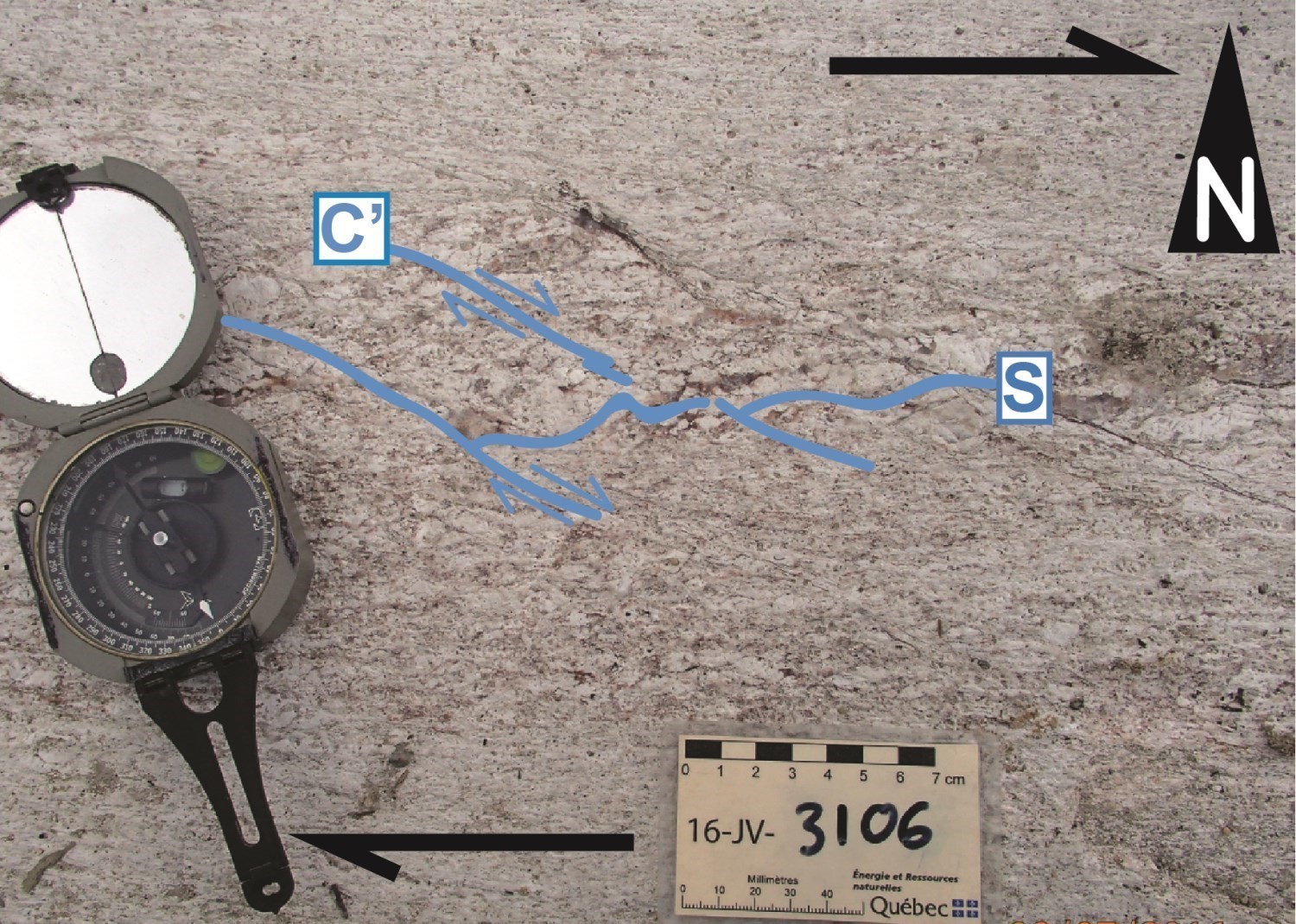
| Author: | Leclerc and Caron-Côté, 2017 |
| Age: | Precambrian / Archean / Neoarchean |
| Reference section: | |
| Type area: | The Nottaway Pluton is located along the Nottaway Deformation Corridor (NTS sheets 32K01, 32K02 and 32K07). It is particularly well exposed on the shores of Poncheville Lake. |
| Geological province: | Superior Province |
| Geological subdivision: | Opatica Subprovince |
| Lithology: | Biotite magnetite ± hornblende granite |
| Unit type: | Lithodemic |
| Rank: | Lithodeme |
| Status: | Formal |
| Use: | Active |
- None
Background
« Ultrametamorphic pink granites » associated with the Nottaway Shear Corridor were initially described in Sawyer and Benn (1993) and have been dated (U-Pb) by Davis et al. (1995). The southern contact of this intrusion was later defined during mapping work by Goutier and Leclerc-Cloutier (2006a and 2006b) using geophysical data. The work of Leclerc and Caron-Côté (2017) allowed to trace the contacts of the unit that were designated as the Nottaway Pluton in NTS sheets 32K01, 32K02, 32K07 and 32K08. The unit boundaries in NTS sheet 32K06 are still to be clarified.
Description

 The Nottaway Pluton is essentially composed of medium to coarse-grained biotite magnetite (± hornblende) granite. The rock has a pinkish beige patina and commonly contains xenoliths of diorite, amphibolite and dioritic gneiss. This intrusion is characterized by heterogeneous deformation marked by rapid changes in structure; massive and homogeneous granite can thus be quickly replaced by a foliated or gneissic granite. In this gneiss, quartzofeldspathic leucocratic bands are commonly hematitized and show a light pink to dark color depending on the intensity of alteration. Melanocratic bands are rich in ferromagnesian minerals such as biotite, magnetite and, more locally, hornblende. In the NW-SE deformation zones of the Nottaway Shear Corridor, granite even develops a mylonitic structure characterized by asymmetric fabrics showing essentially dextral movement (Sawyer and Benn, 1993).
The Nottaway Pluton is essentially composed of medium to coarse-grained biotite magnetite (± hornblende) granite. The rock has a pinkish beige patina and commonly contains xenoliths of diorite, amphibolite and dioritic gneiss. This intrusion is characterized by heterogeneous deformation marked by rapid changes in structure; massive and homogeneous granite can thus be quickly replaced by a foliated or gneissic granite. In this gneiss, quartzofeldspathic leucocratic bands are commonly hematitized and show a light pink to dark color depending on the intensity of alteration. Melanocratic bands are rich in ferromagnesian minerals such as biotite, magnetite and, more locally, hornblende. In the NW-SE deformation zones of the Nottaway Shear Corridor, granite even develops a mylonitic structure characterized by asymmetric fabrics showing essentially dextral movement (Sawyer and Benn, 1993).
Thickness and distribution
The Nottaway Pluton is an NW-SE oriented intrusion and outcrops more than 75 km parallel to the Nottaway Shear Corridor route (NTS sheets 32K01, 32K02, 32K07, 32K08). The width of the intrusion reaches 15 km and it covers an area of approximately 1300 km2.
Dating
Analysis of sample OP250, a granite showing well-developed C-S fabrics sampled in the Nottaway Shear Corridor, gave a crystallization age of 2686 ±4 My (TIMS, U-Pb on zircons; Davis et al., 1995).
| Isotopic System | Mineral | Cristallization Age (My) | (+) | (-) | Reference(s) |
| U-Pb | Zircon | 2686 | 4 | 4 | Davis et al., 1995 |
Stratigraphic Relationship(s)
The Nottaway Pluton (2686 ±4 My, Davis et al., 1995) cuts diorites of the Ouescapis Pluton (2693 ±1 My, Davis et al., 1995).
Paleontology
Does not apply.
References
| Author(s) | Title | Year of Publication | Hyperlink (EXAMINE or Other) |
|---|---|---|---|
| DAVIS, W.J. – MACHADO, N. – GARIÉPY, C. – SAWYER, E.W. – BENN, K. | U-Pb geochronology of the Opatica tonalite-gneiss belt and its relationship to the Abitibi greenstone belt, Superior Province, Quebec. Canadian Journal of Earth Sciences; volume 32, pages 113-127. | 1995 | Source |
| GOUTIER, J. – LECLERC-CLOUTIER, J.-F. | Compilation géoscientifique – Géologie 1/50 000 – 32K02 – Lac Poncheville. Ministère des Ressources naturelles et de la Faune, Québec; CG SIGEOM 32K. Échelle 1/50 000. | 2006a | CG SIGEOM 32K |
| GOUTIER, J. – LECLERC-CLOUTIER, J.-F. | Compilation géoscientifique – Géologie 1/50 000 – 32K01 – Lac Yapuouichi. Ministère des Ressources naturelles et de la Faune, Québec; CG SIGEOM 32K. Échelle 1/50 000. | 2006b | CG SIGEOM 32K |
| LECLERC, F. – CARON-CÔTÉ, E. | Geological survey from the Opatica sub-province northeast of Matagami (Amisquioumisca Lake region). Ministère de l’Énergie et des Ressources naturelles, Québec. | 2017 | Bulletin géologiQUE |
| SAWYER, E.W. – BENN, K. | Structure of the high-grade Opatica Belt and the adjacent low-grade Abitibi Subprovince, Canada : an Archean mountain front. Journal of Structural Geology; volume 15, pages 1443-1458. | 1993 | Source |

